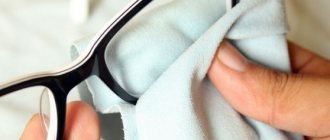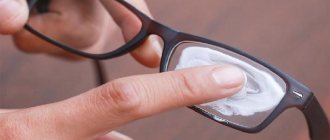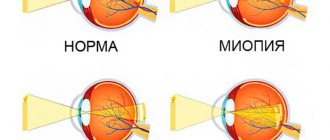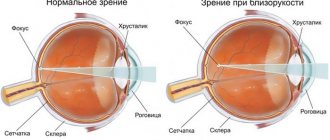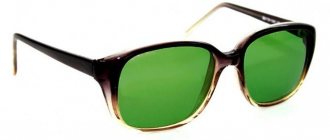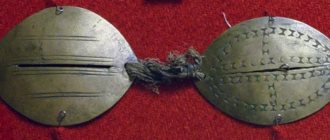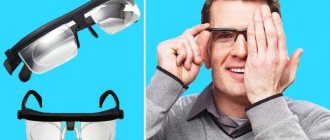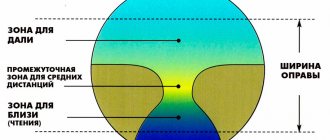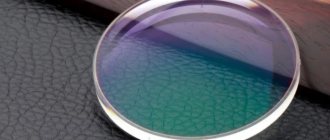Myopia is a vision pathology in which the image falls on the area in front of the retina. As a result, a person has difficulty distinguishing objects located at a distance from him. This defect can be corrected, including with the help of glasses. However, not everyone knows when to wear them and what mode of wearing to choose.
Whether you should wear glasses at all and whether you need to do this on a regular basis is determined by your doctor after a vision examination, during which he will determine the degree of myopia. The mode of wearing glasses depends on it
Types of myopia by severity:
- weak (initial) (less than 3.0 diopters);
- average (from 3.25 to 6 diopters);
- high (more than 6 diopters).
Features of progressive lenses
Just a few years ago, glasses for vision correction for myopia and farsightedness could be found separately on sale. Progressive lenses for glasses provide a person with poor vision with a smooth transition from near to distant objects. Due to this, a clear vision of the surrounding world is ensured at any distance from a person.
The disadvantage of this optics is that lateral vision is difficult; a person cannot normally see objects located on the periphery. But many ophthalmologists do not consider this a significant drawback, since you can easily turn your head and examine objects of interest.
Progressive lens glasses are multifocal. They are divided into two zones, at the bottom an area for viewing objects near, and at the top for distant objects. You just need to move your gaze to see clearly at any distance. Between these two areas there is a transition zone, which allows you to clearly see objects located at medium distances.
It is important to remember that the difference between such zones on progressive glasses should not be more than 3 diopters. If the patient has a higher indicator, then regular glasses are selected.
Manufacturing optics of this type is quite labor-intensive. Some experts compare this production with jewelry work. This ultimately affects the price of the products. Not every person with poor vision can afford such lenses.
What glasses are needed - plus or minus?
Usually a farsighted person has several pairs of optics in his arsenal - for reading, driving, sun protection. How to choose the right glasses for different situations with farsightedness depends on the severity of the refractive error.
Degrees of hypermetropia are measured in diopters. Glasses are selected with positive glasses, that is, those that increase the refractive power:
- with a weak degree, less than 3 diopters, you need glasses for reading and working with a computer;
- with an average degree, up to 6 diopters, correction devices are prescribed for constant wear;
- with severe farsightedness, more than 6 diopters, you will need several sets for reading, working and constant wearing.
Sometimes a person needs multifocal glasses, consisting of several lenses with different refractive powers.
You can find out what biofocal glasses are in the following video:
Optics are always selected individually; the doctor uses a diopter table to determine the degree of farsightedness.
You can see the rules for spectacle correction for hypermetropia in the video:
For adults
Age-related farsightedness is called presbyopia and is associated with changes in the elasticity of the lens. The progression of this condition cannot be slowed down by eyeglass correction, so it is not necessary to wear them all the time.
But adults with farsightedness need chameleon glasses. They darken in sunlight and protect the lens from damage, preventing the development of cataracts. Presbyopic glasses are worn when working with small objects or reading.
Progressive lenses are suitable for everyday office and home work at any time of the day. More details in the video:
For children
Visual correction products for children are also selected individually. The difference from adults is that lenses need to be changed more often. They are made from glass or plastic. Glass lenses are more resistant to damage, while plastic ones are safer.
Hypermetropia and myopia do not occur at the same time, but individually they can be combined with astigmatism and strabismus. In such cases, complex vision correction devices are prescribed.
It is important for children to choose beautiful and comfortable frames. It is made of durable plastic and will not rub the bridge of your nose or ear. A child does not need to constantly wear glasses for farsightedness if it is mild. They are worn while studying, working with a computer, or watching TV.
Types of progressive optics
Nowadays you can buy different types of progressive lenses. Their difference is in purpose, design and manufacturing technology. You can choose frames individually for your lenses, which will only add zest to your look.
Standard
Standard ones are made from half-finished lenses that already have a progressive front surface. According to a doctor's prescription, the back part of such a lens is modified, giving it a special spherocylindrical shape. It is worth understanding that the quality of vision in such glasses will not be very good. But the cost of manufacturing such glasses is low, which explains the high prevalence of this optics.
Customized
Such lenses are also called optimized. When making them, they rely not only on the prescription prescribed by the ophthalmologist. A non-progressive surface is used in this case to correct possible distortions that progressive lens glass can cause. In some lens models, the optical power changes from top to bottom. To manufacture such optics, a special technology is used, which makes it possible to obtain surfaces of various shapes.
Individual
In this case, the design is calculated taking into account the patient’s vision and head movement characteristics. The frame chosen by the person is also taken into account. These progressive lenses are considered the most advanced, they provide high quality vision.
Should I wear glasses all the time if I have mild myopia?
Correction of myopia at an early stage is required when visual acuity is from − 1 to − 3 diopters. It is not necessary to wear glasses up to minus 1 diopter, since this eye condition does not cause serious inconvenience. In this case, the ophthalmologist usually prescribes eye exercises. If you perform the prescribed set of exercises daily, you will be able to avoid the development of the disease.
For myopia from 1 to 3 diopters, the doctor prescribes wearing glasses. But you should wear them as needed: while watching TV, in the theater, driving a car, that is, in situations where you need to focus on distant objects. In other cases, for example, when reading or writing, it is better not to use optics.
When viewing objects close to the eyes with distance glasses, the reserve of accommodation decreases. The eyes become overstrained, the eye muscles become tired, and the person loses the ability to tune in to examine objects located at different distances from him. This leads to decreased vision.
Advantages and disadvantages
Progressive optics have many advantages. First of all, it is the ability to accurately select lenses that take into account all the features of vision. The advantages include the following:
- There is no need to buy several types of glasses at once. With progressive glasses you can see equally well both near and at a distance.
- Can be used both at work and at home.
- There is no blurring in the eyes when suddenly shifting vision from one object to another.
- Quite presentable appearance.
- Possibility of manufacturing from different materials.
- You can order custom made optics.
- Vision remains clear when viewing objects in any direction.
There is only one drawback to high-quality progressive lenses - their high price. If a person buys standard progressive glasses, he must remember that they will not provide high quality vision.
An ophthalmologist should select optics. A person without certain knowledge cannot choose glasses for himself so that they take into account all his visual features.
Pros and cons of contact lenses
Contact lenses are comfortable, tinted ones are also beautiful, they work no worse than glasses, but their main advantage is the possibility of active pastime. In the summer, they allow you to wear different sunglasses without wasting money on expensive photochromic lenses of regular glasses. At the same time, solar glasses can be varied and very cheap, which is unacceptable for glasses with diopters (after all, they don’t skimp on vision). However, this advantage of contact lenses directly depends on the cost of the lenses themselves, and they are not worn forever (they need to be changed), and are essentially fictitious, since glasses do not require a container, a special liquid for storage, or periodic replacement.
Cons of contact lenses:
- from ophthalmologists: a lens is a foreign body in the eye;
- risk of infection;
- severe complications in case of violation of the rules of wearing and care: keratitis, conjunctivitis, corneal ulcer;
- the need for special care and constant use of fresh special fluid;
- the presence of a period of adaptation to the lenses;
- the need to learn to put on lenses and bring movements to automaticity;
- problems with hydration when using long-term (not daily) lenses, which forces you to always carry special drops with you;
- the process of putting on lenses: it is so “simple” and “convenient” that there are a lot of guides on the Internet on how to sit down, how to bend over, how not to blink, what the light should be like, how to position your fingers, etc. (this makes for a full-length article) and how to repeat it, if it didn’t work out the first time, but your eyes don’t feel good for a few minutes;
- “registration” in the ophthalmologist’s office (once every 3 months as a preventative measure; if anything goes wrong, go to the doctor: problems with lenses cannot be solved on their own).
The huge number of disadvantages of contact lenses (compared to glasses) has given rise to a huge number of myths.
How to choose and how much they cost
You can’t select progressive optics on your own. You should first visit an ophthalmologist and undergo a full examination. Only after the doctor determines visual acuity and all the nuances of the visual system can a prescription be issued.
The cost of custom-made glasses is quite high, so such optics are not affordable for all people with poor vision. More often they order traditional glasses, which are made on the basis of standard lens glasses. It is worth understanding that such glasses cannot provide very good vision, since their production is formulaic and image distortion caused by progressive lenses is not eliminated.
When choosing, you should take into account the shape of the frame and the material from which it is made. It has been observed that glasses with metal frames last longer.
What level of vision requires glasses?
The ophthalmologist decides for which vision the patient needs to wear glasses individually. This is influenced by factors such as age and the disease itself.
Visual acuity is measured in diopters. This is the refractive power of the light flux.
For myopia
Thanks to special studies, it was revealed that glasses for myopia (myopia) must be worn when working or watching TV with visual acuity from -0.75 diopters to -3 diopters. If the patient's vision is -3 or more, optics are prescribed for constant wear.
In addition, myopia is divided into two types: accommodative and anatomical. With anatomical form, wearing glasses is necessary. This is due to the fact that such pathology tends to progress. Vision correction optics can prevent this. With the accommodative variety, the task of the treating specialist is to strengthen the muscles of the visual apparatus. In this case, wearing glasses can be harmful, since the muscles relax in this case. The best solution would be to perform special gymnastics for the eyes.
For farsightedness
Glasses for farsightedness (hyperopia) are prescribed at values of +0.75 diopters. They can be prescribed for both temporary and permanent wear. If the patient does not have concomitant eye diseases (astigmatism, myopia, etc.) and objects lose their contour only at close range, the patient is prescribed optics for temporary use. They are worn when reading, writing, working on a computer, watching TV, driving, and doing minor work.
The decision to make adjustments using glasses is made by the doctor individually for each patient. Even with poor vision, if this does not bother you in any way, corrective optics may not be prescribed.
Terms of use
According to people, wearing progressive glasses takes some getting used to. To do this, you should start using them on weekends or during vacation. It is important to completely abandon old glasses and always wear only progressive optics.
In a calm environment, you need to learn to focus your gaze on the book in your hands, and then move it into the distance, looking at objects in the back of the room.
It is especially difficult at first to go up and down the stairs. Quite often people simply lower their gaze, but when using progressive lenses this is not enough; you also need to tilt your head a little to look through the middle zone.
When do you have to wear glasses all the time?
At the middle stage of myopia, a person, as a rule, has poor vision both far and near. Then you have to alternately wear two pairs of glasses. Often, an ophthalmologist will prescribe glasses with bifocal lenses. The patient looks through the lower or upper parts of the lenses, depending on the situation. In the third degree, you will have to wear glasses, taking them off only at night, otherwise the disease will progress.
You can find out if you have myopia yourself. To do this, just take an online test on your computer. Now there are many programs that allow you to check your vision for free, without leaving your home. However, you will not be able to prescribe treatment and select corrective means. Only a specialist will determine the degree of the disease and advise you on the appropriate glasses wearing regimen for your eyes.
